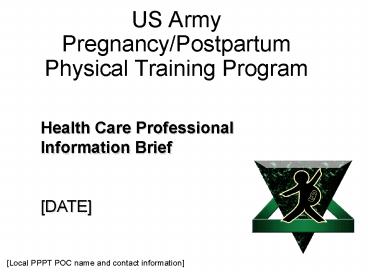US Army PregnancyPostpartum Physical Training Program - PowerPoint PPT Presentation
1 / 19
Title: US Army PregnancyPostpartum Physical Training Program
1
US Army Pregnancy/Postpartum Physical Training
Program
Health Care Professional Information Brief
DATE
Local PPPT POC name and contact information
2
Purpose
- Overview of program
- Local implementation process
- Health care professional roles
3
Facts
- Army has a responsibility to provide safe,
adequate training and guidance to meet required
fitness and weight standards - Exercise by a healthy Soldier during pregnancy
and postpartum is beneficial to both Soldier and
baby - Goals are to maintain fitness during pregnancy
and to return fit Soldiers back to unit PT after
delivery - The health and safety of the Soldier and baby can
be maximized by a standardized program.
4
Challenge Maintain Fitness and Retention
- 1.3 AD Force delivers a baby annually
- No PT guidance or standardization Army-wide
- Reduction in fitness levels
- Increase in injuries/ illnesses
- Current Army policies inadequate and fragmented
- Army Family Action Plan issue 532
5
Solution
- WHAT?
- Establishment of Army-wide PPPT program IAW
MEDCOM recommended standards and policies - HOW?
- G3/5/7 mandate approved PPPT Program as a
component of US Army Physical Fitness Program
with coordination from MEDCOM and ACSIM. - WHY?
- Consistent with AR 350-1, Education and Training
and AR 40-501, Standards of Medical Fitness - Meets AFAP recommendations
- Shown to be effective and safe
- Provides benefits of readiness/medical cost
avoidance
6
Program Timeline
Program Development
Briefing
7
Science-Based Program
Affect Readiness by Maximizing the Return to
Fitness
Recommend implementation of pregnancy/postpartum
fitness programs at all installations with
emphasis on consistency, strength and aerobic
conditioning.
8
Coordination
- The Army Surgeon General
- OTSG medical and nursing consultants
- OB/GYN, Womens Health
- Commandant, US Army Physical Fitness School
- FORSCOM G-1 and FORSCOM Surgeon
- TRADOC Surgeon
- RC and ARNG Surgeons
- HQDA, G-1 Human Resources Policy Directorate
- IMA, Deputy Director
- USACHPPM CG, DTS and subject matter experts
9
Program Evaluation
- Readiness Impact
- Pre-pregnant vs. Post-delivery APFT measures
indicate FITNESS LEVELS MAINTAINED - No statistically significant difference in
- pre-pregnant and post-delivery APFT total scores
- Retention Impact
- 14 PPPT participants influenced by program NOT
to Chapter 8 - Economic Benefit (using existing personnel for
local programs) - Cost per enlisted pregnancy per recurring year
47 - ROI benefit to cost ratio 73.5
- Estimated readiness and medical cost avoidance
20K - per year
10
Local PPPT Implementation Commanders
Consolidated Installation Program
PREGNANCY
POSTPARTUM
9 Months
6 Months
Diagnosis
Convalescence
Profile Recovery
Postpartum PT
APFT
Delivery
6 Wks
4 Wks
40 Wks
Up to 14 Wks
Physical Training in Unit Pregnancy PT Program
Physical Training in At-Home Postpartum PT
Program
Physical Training in Unit Postpartum PT Program
Regular unit PT activities begin at conclusion
of 6-month recovery period as outlined in AR
350-1.
11
Proposed PPPT Leadership
US Army Physical Fitness Training Program
Specified Proponent
Commanders Consolidated Installation Program
Local PPPT Personnel
Command Asset Instructor Trainer
MTF Asset Medical Expert
NCOs from the units
Exercise Leaders
Active Duty pregnant/postpartum Soldiers
accountable to unit for attendance
All leaders trained in pregnancy/postpartum
fitness
12
Local Personnel Roles
- Medical Expert (ME)
- Medical oversight and quality control
- Consultative services for IT and EL
- Coordinator of Health Education Classes
- Assist in EL training
- Instructor Trainer (IT)
- Liaison with units
- Operate PPPT program
- Train Exercise Leaders
- Collect program outcomes data
- Exercise Leaders (EL)
- Lead program exercise sessions
- Assist with Soldier accountability
- Recommend using NCOs with fitness backgrounds
13
Pregnancy/ Postpartum Exercises
- Centering
- Strengthening
- Flexibility
- Special exercises
- Cardiovascular
- Relaxation/ Stress Management
- Core strength/ calisthenics
14
Education
- Core Curriculum
- OTSG consultant approved presentations
- Available on PPPT website
- Wide variety of topics
- Taught weekly by SMEs
- Provide awareness, knowledge, skills training
15
PPPT Program Resources
- Manuals
- Video Tapes
- Implementation Guide
- Educational Presentations
- USACHPPM Website
- http//usachppm.apgea.army.mil/dhpw/Readiness/PPPT
.aspx - Resources
- Marketing tools
- Data reports
- Sample briefings
- Leader Training Course
16
HCP - you have a part to play!
- Provide clear pregnancy and postpartum profiles.
- Direct pregnant Soldiers to the PPPT Program.
- Encourage healthy Soldiers to attend.
- Volunteer to teach a health education class in
your area of expertise. - Share positive stories about the PPPT Program
with Commanders.
17
Frequent Local Challenges
- Follow standardized content consistently
- Partner with other organizational personnel
- Plan for Soldiers returning to units early
- Encourage active participation
- Maintain funding for sustainment
- Receive leader training by SME
- Collect follow-up data
18
Frequently Asked Questions
- Is the PPPT program treated differently than
other Army special population PT programs? - No, per TSG
- Are Soldiers required to wear the PT uniform?
- Yes, until it no longer fits and then they can
either wear a larger size or wear appropriate
civilian fitness clothes - (no tight or short tops)
- Are family members allowed to attend PPPT?
- No, this is an Army unit PT program with military
goals - Can the program be mandatory?
- Attendance may be the Soldiers place of duty
after HCP clearance to participate has been given
19
Feedback
- Your questions for us
- Your comments are welcome































